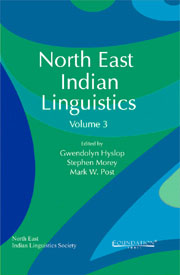1 - Person-Marking Prefixes of Purum
from The View from Manipur
Published online by Cambridge University Press: 26 October 2011
Summary
Introduction
Purum is a language belonging to the Kuki-Chin group of the Tibeto- Burman family (Grierson 2005 [1904]). Benedict includes the language under Kuki-Naga (Kukish) (Benedict 1972). The word Pu rum means ‘hide from tiger’ (Shakespear 1912: 150). Purum is recognized as one of the 33 languages spoken in Manipur by the State Government of Manipur, and the language is considered to be highly endangered. According to the Census of India (2001), the number of Purum speakers is 503. The teaching of the language has not yet been introduced even at the primary level of school education. There are two Purum villages, situated in the Senapati district of Manipur. The names of these villages are Purum Khullen and Purum Likli; the former is about 18 kms and the latter 27 kms north of Imphal (the capital of Manipur). Most Purum speakers are able to speak Manipuri due to the fact that they are in contact with Manipuri speakers through education, administration, business transactions, and so on.
There has been confusion as to whether two groups, the Purum and the Chote, are the same, as we can see from the title of the proceedings of a symposium held in 1985, “Proceedings of the Symposium on Purum (Chote) Revisited”. In those proceedings, Hiyang et al. point out that the name Chote, which has later come to be spelled Chothe, seems to be confused with Purum because the Chothe people settled in some places called Purum (Hiyang et al. 1985: 25–26).
- Type
- Chapter
- Information
- North East Indian Linguistics , pp. 3 - 23Publisher: Foundation BooksPrint publication year: 2011
- 2
- Cited by



